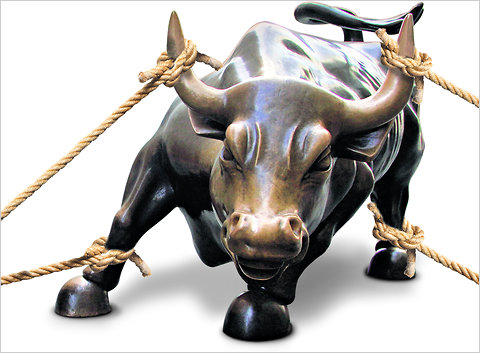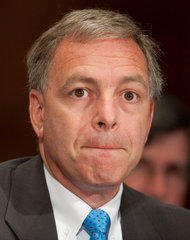 Illustration by The New York Times
Illustration by The New York Times
With firms like Goldman Sachs and Morgan Stanley reporting weak results for last year, Wall Street is having to confront doubts about itself.
Is this a temporary slump? Or will the moneymakers never get to go back to their high-rolling ways? Many on Wall Street had hoped 2011 would be a year when the investment banks showed that they could still make solid profits in the more sober financial environment that has followed the 2008 crisis.
Instead, Goldman Sachs’s earnings fell 67 percent last year; Bank of America’s investment banking operation, which includes Merrill Lynch, suffered a 53 percent decline in net income; and Morgan Stanley’s earnings were down by 42 percent.
Some of the forces that weighed on earnings last year — like Europe’s government debt crisis and a sluggish United States economy — could go away. Yet Wall Street still faces permanent pressures on profitability, particularly stricter regulations aimed at making the financial system safer. For instance, Wall Street firms cannot borrow such large amounts of money and make bets with it. With much less of this kind of leverage, the game is changed — perhaps forever.
“No matter how you cut it, the Goldman Sachs of tomorrow is not going to be the Goldman Sachs of 1999, when it did its I.P.O., or the Goldman Sachs of 2006, when it was at the high point of the cycle,” said Brad Hintz, a senior analyst with Sanford C. Bernstein Company.
 Andrew Harrer/Bloomberg NewsAsked about downsizing at Goldman Sachs, David A. Viniar, chief financial officer, said that was “a very difficult” question.
Andrew Harrer/Bloomberg NewsAsked about downsizing at Goldman Sachs, David A. Viniar, chief financial officer, said that was “a very difficult” question.
As profits fall way short of internal targets, the executives who run Wall Street may have to cut back hard, to stop profits from falling even further. When asked by an analyst on Wednesday whether Goldman Sachs was thinking of downsizing to deal with the difficult business conditions, David A. Viniar, the bank’s chief financial officer, said, “That is one of the most critical questions and a very difficult one to answer.”
Wall Street employees are feeling the squeeze this bonus season, which is going on right now. In 2011, Goldman set aside $12.22 billion to pay compensation and benefits for its 33,300 employees. That comes out to around $367,000 per person. In 2006, the firm paid out $16.46 billion in compensation and benefits, or roughly $621,000 per employee. At Morgan Stanley, which lost money in the fourth quarter, cash bonuses were capped at $125,000 per person.
The retrenchment has hurt morale among lower-tier workers. Young bankers and traders fresh out of Ivy League universities can no longer count on earning more than their peers in other prestigious industries, such as management consulting and law. Rounds of layoffs, which used to be aimed mainly at senior and midlevel employees, have cut through the junior ranks this year at firms like Credit Suisse, and bonuses are down for nearly everyone.
At Goldman Sachs, some young analysts — a group that could earn year-end cash bonuses of up to $80,000 in better years — were given as little as $20,000 this year, according to one person with knowledge of this year’s numbers.
On Wall Street, much depends on a financial performance metric, return on equity, which effectively measures the profits a bank was able to generate on its capital. If a bank made $1 billion in profits on $10 billion of equity, its return on equity would be 10 percent.
In the middle of last year, Goldman Sachs’s target for return on equity was 20 percent, though the firm has since retreated from setting a target, citing the uncertainty in its business. Its actual return last year was only 3.7 percent, compared with 33 percent in 2006. Morgan Stanley managed 4 percent in 2011, compared with 23.5 percent in 2006.
Analysts estimate that Goldman effectively pays 10 to 15 percent for its capital. As a result, in 2011, the firm did not even cover the cost of its capital.
 Jim Lo Scalzo/European Pressphoto AgencyRuth Porat, Morgan Stanley’s chief financial officer, said return on equity would rise, but would not go back to its past heights.
Jim Lo Scalzo/European Pressphoto AgencyRuth Porat, Morgan Stanley’s chief financial officer, said return on equity would rise, but would not go back to its past heights.
Morgan Stanley encapsulates the quandary facing a big Wall Street firm: Attempts to diversify may not help profitability. Over the last few years, rather than rebuild trading desks that were taking a lot of risks, Morgan Stanley has shifted its focus to wealth management, a steadier business, but that could mute returns.
“Do I expect to see a return to a return on equity in the mid-20s like the old days? No, but is there a path to the midteens over time? Yes,” said Ruth Porat, Morgan Stanley’s chief financial officer, in an interview on Thursday.
Wall Street firms operate under a tougher regulatory environment than existed in 2008. One of regulators’ first responses to the crisis was to make banks raise extra capital, to increase their buffer against losses, and they were told to use less short-term borrowed money to finance their businesses, which made them less vulnerable to runs. At the end of its 2007 fiscal year, Morgan Stanley’s $1.05 trillion of assets was supported by only $30 billion of equity. At the end of 2011, its equity was up to $60.5 billion and its assets were down to around $750 billion.
These adjustments effectively make it impossible to get back to the returns on equity achieved in the glory days. With double the equity, Morgan Stanley would now need to double profits, from a smaller pool of assets, to get back to its mid-2000s returns.
While some of 2011’s challenges may ease this year, Wall Street has to grapple with new regulations in 2012 that could whack profits.
The new rules take aim at businesses in which Wall Street has traditionally made its fattest profit margins, like bond trading and trading in financial instruments called derivatives.
The Volcker Rule, which is aimed at stopping banks from making financial bets for their own accounts, could permanently eat away at bond trading revenue. Efforts to strengthen the derivatives market — such as making sure that trades are properly backed with collateral — could deplete the profitability of this business.
Mr. Hintz estimates that a Wall Street bank currently makes a 35 percent profit margin on its derivatives businesses, but he thinks the new rules could shrink that to 20 percent.
Despite the pessimistic outlook, the fittest Wall Street firms will no doubt make a Darwinian bid to profit as weaker firms falter.
United States banks could pick up new business in Europe, for instance. In November, the Swiss banks UBS and Credit Suisse announced big cuts in their securities businesses, and the Italian bank UniCredit recently said it was closing its equities business in Europe. And some United States banks may decide to retreat from certain activities, allowing others to pick up the business.
The first part of this year may see a rebound in business, as investors venture back into the market. This occurred in the first part of 2009, once fears lessened.
“You could see a couple of blockbuster quarters as pent-up demand comes back,” said Roger Freeman, a senior analyst with Barclays Capital. But he says revenue may taper off if new regulations bite.
Still, Jamie Dimon, the chief executive of JPMorgan Chase, struck a more optimistic note in talking to reporters in a conference call last Friday. Noting that there were always swings in the investment banking business, he said, “I think when things come back, these numbers could boom again.”
Bank of America’s chief financial officer, Bruce R. Thompson, said he thought the continued downdraft in trading revenue was temporary, rather than representing a long-term shift in the Wall Street landscape.
“There’s always this question of what’s normal versus what’s not,” he said, adding that the first few weeks of 2012 had seen a pickup in trading activity.
If his optimism proves wrong, and revenues remain depressed, though, more cuts loom. “Operating at a loss,” Mr. Thompson said, “isn’t something we will continue to want to do.”
Kevin Roose and Nelson D. Schwartz contributed reporting.
Article source: http://feeds.nytimes.com/click.phdo?i=d3f9dc3b68c8038344df2f7a573cf8e7
Speak Your Mind
You must be logged in to post a comment.